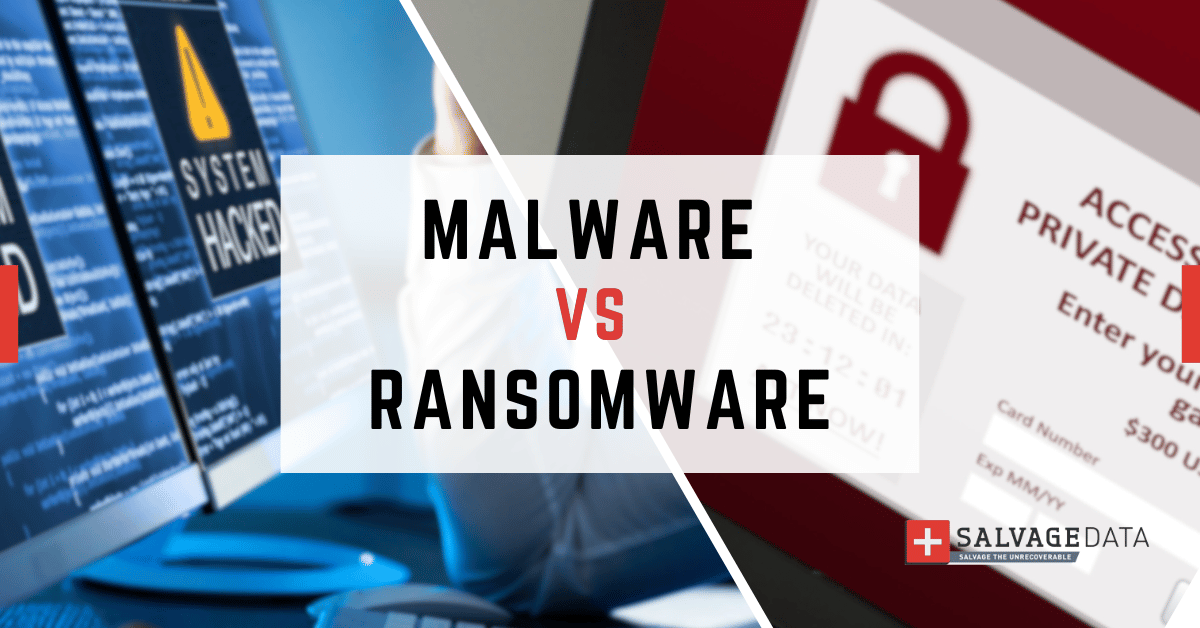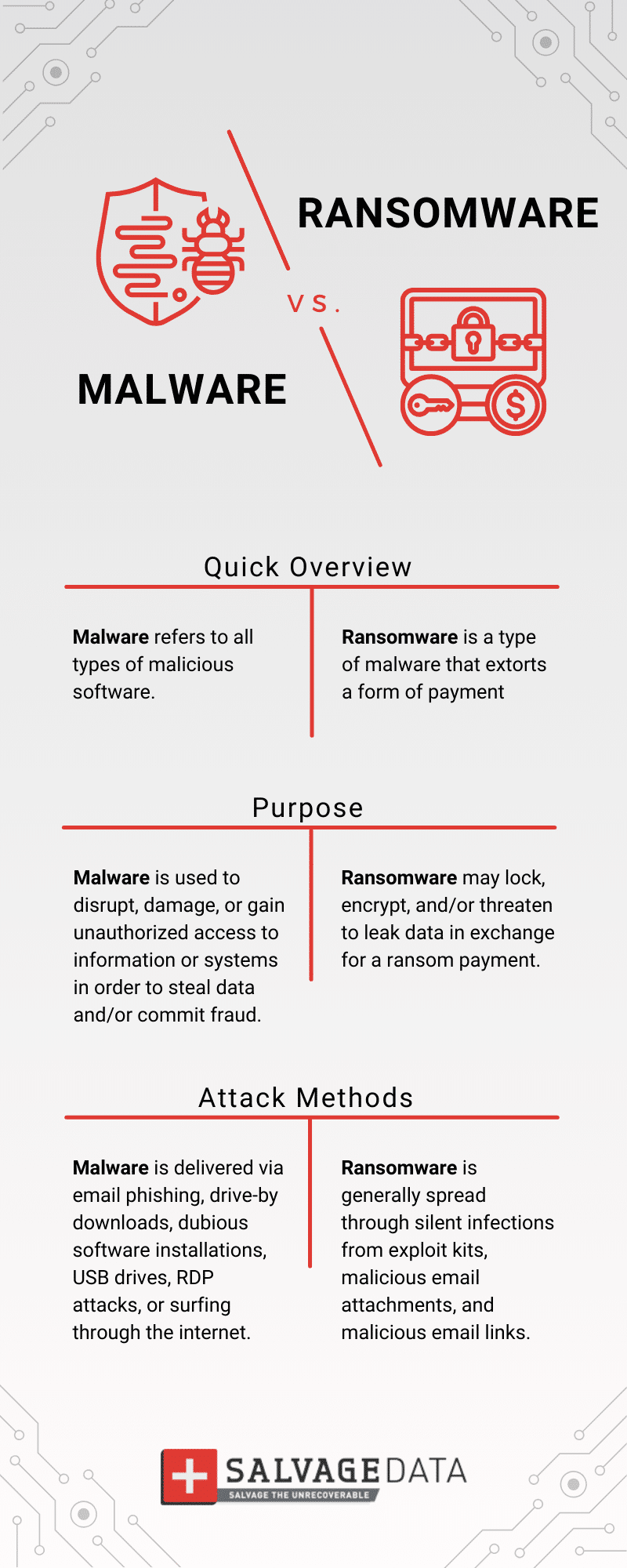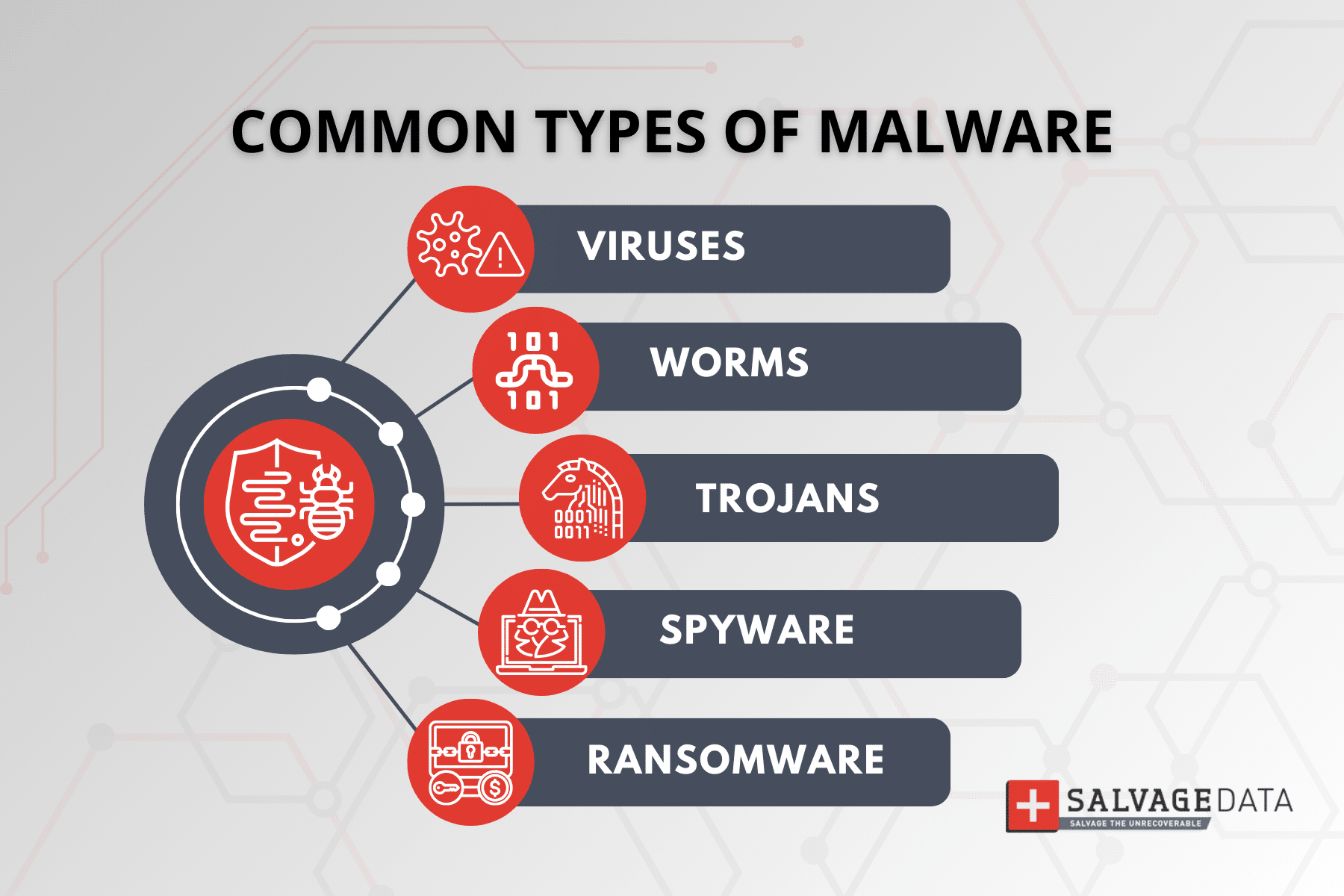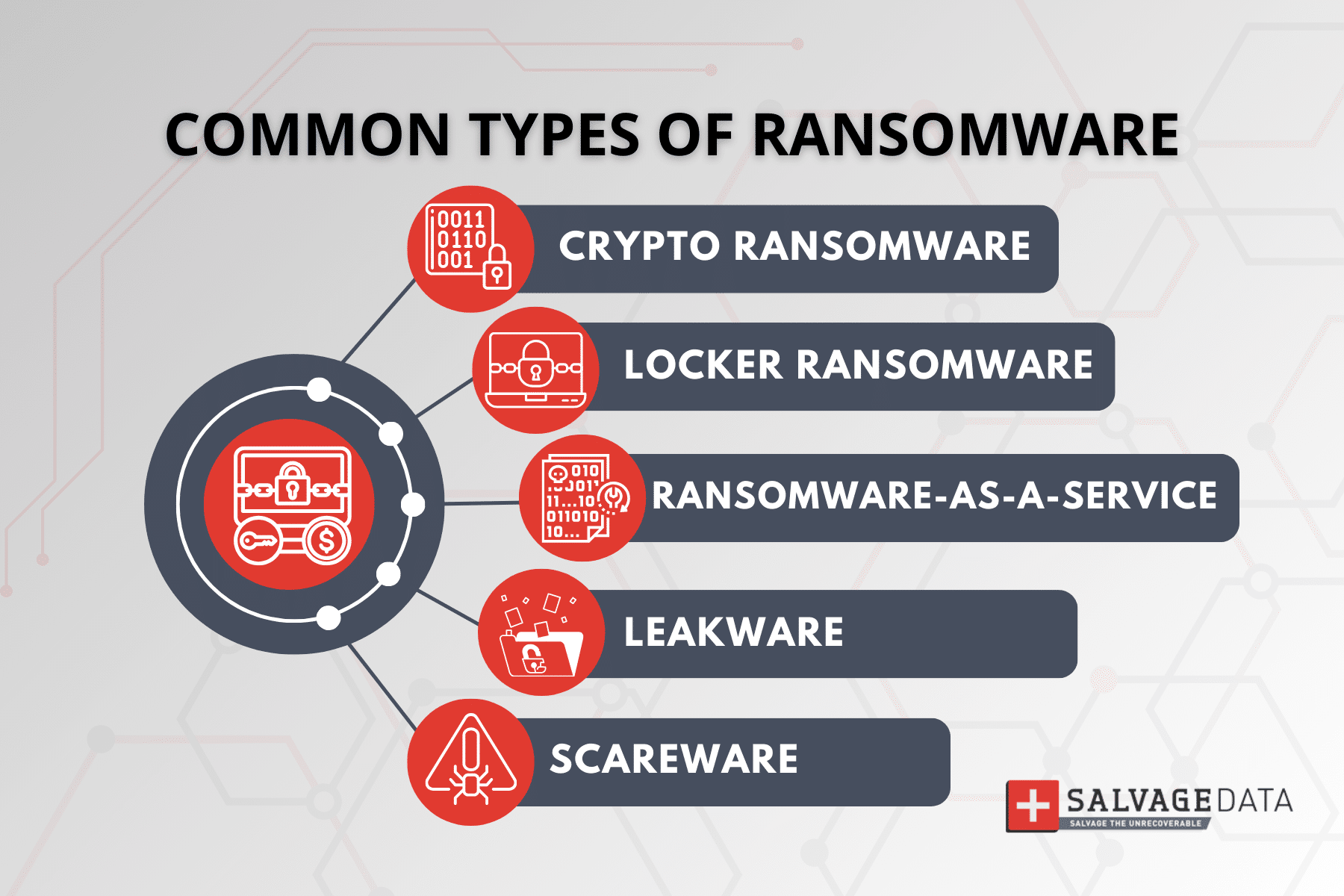Recent Articles
How To Recover Overwritten Files
The Snowflake Data Breach: A Comprehensive Overview
Mac Not Recognizing External Hard Drive: Quick Fix Solutions
How Multi-Cloud Backup Solutions Can Prevent Data Disasters
Capibara Ransomware: What is it & How to Remove
What Should a Company Do After a Data Breach: The Ticketmaster Incident
Secles Ransomware: Removal Guide
What To Do When Your Chromebook Freezes
How to Create Hyper-V Backup
What Is The Best Data Recovery Software For PC

I think there's an issue with my storage device, but I'm not sure Start a free evaluation →
I need help getting my data back right now Call now (800) 972-3282
Malware and ransomware are two terms that are often used interchangeably, but they describe different types of cyber crimes.
Malware is an umbrella term that includes all types of malicious software, while ransomware is a type of malware that encrypts a victim’s files and systems and demands payment in exchange for access to those files.
In layman’s terms, malware can be compared to your wallet getting stolen and ransomware is closer in comparison to being mugged or blackmailed.

What is Malware
Malware, short for malicious software, is any program or file designed to disrupt a computer, network, or server. Cybercriminals can also use malware to deliver toolkits for future attacks or to steal data.
Usually, Malware is employed by cybercriminals to carry out fraudulent activities, including making unauthorized purchases, transferring money from accounts, changing account settings, and stealing personal information. These threat authors use different types of malware to infiltrate devices and networks, including viruses, worms, Trojan horses, ransomware, and spyware.

Types of malware
Although there are many types of malware, they all represent great danger to your business and personal information.
It is essential to understand the different types of malware to protect against them. Preventative measures include keeping software and operating systems up to date, using antivirus software, and backing up data regularly.
Virus
A computer virus is a malicious piece of computer code designed to spread from device to device. They can cause significant damage to data files and systems, leading to reduced performance and even system crashes. Some viruses can give their cybercriminal creators a backdoor to destroy or steal sensitive data and documents.
It works by infecting files or system areas of a computer or network router’s hard drive and then making copies of itself.
Computer viruses can spread through various methods, such as malicious online downloads, infected email attachments, or by plugging in infected hardware like an external flash drive (USB stick).
Worms
A computer worm is a self-replicating type of malware that operates by spreading copies of itself from one device to another without requiring human interaction. They can cause significant damage to data files and systems, leading to reduced performance and even system crashes.
It works by exploiting vulnerabilities in software, such as operating systems, applications, or network services. Worms can also be used to install backdoors, steal data, and enable threat operators to take control of a computer and its dedicated system settings.
Computer worms can spread through various means, such as emails, instant messages, file-sharing networks, or by exploiting software vulnerabilities.
Trojans
Trojan malware, also known as Trojan horses, is a type of malware that disguises itself as legitimate software or content to trick users into downloading and executing it. Once installed, a Trojan can perform the action it was designed for, such as stealing sensitive data, installing additional malware, or giving hackers remote access to the infected device.
Trojans can spread through various means, such as email attachments, software downloads, or by exploiting software vulnerabilities.
Adware
Adware, short for advertising-supported software, is a type of malware that displays unwanted advertisements on a user’s device. It works by installing itself on a computer and automatically displaying ads, which can be intrusive and annoying for users.
Some adware programs can also collect personal information, such as login credentials, banking information, and personal data, and send it to third parties. Plus, this malware can slow down your computer, cause crashes and freezes, and change your DNS settings or manipulate your browser to redirect you to malicious sites.
Adware can spread through various means, such as email attachments, software downloads, fake advertisements, or by exploiting software vulnerabilities.
Spyware
Spyware is a type of malicious software that gathers information about a person or organization and sends it to another entity without the user’s consent. It can collect personal information, such as login credentials, banking information, and personal data, and send it to third parties.
This malware can monitor your internet activity, track login credentials, and spy on sensitive information. Plus, it also interferes with the control of your device and potentially leads to identity theft or data breaches.
Spyware can spread through various means, such as email attachments, software downloads, or by exploiting software vulnerabilities.
Rootkits
A rootkit is a collection of malicious software tools designed to enable unauthorized access to a computer or an area of its software. It can give a threat actor remote access to and control over a computer or other system. Rootkits are particularly dangerous because they can conceal their presence within an infected system, making them hard to detect and remove.
This malware achieves its objectives by modifying the behavior of core parts of an operating system through loading code into other processes, the installation or modification of drivers or kernel modules, and subversion or evasion of standard operating system security tools and application programming interface (API) used for diagnosis, scanning, and monitoring.
Rootkits can be installed during phishing attacks or employed as a social engineering tactic to trick users into giving the rootkits permission to be installed on their systems. They can also exploit software vulnerabilities in operating systems or applications to gain access to a system.
Keyloggers
A keylogger is a type of spyware that records and steals consecutive keystrokes that a user enters on a device. It can be software-based or hardware-based.
Software-based keyloggers are the most common type of keylogger and consist of applications that have to be installed on a computer to steal keystroke data.
Hardware-based keyloggers are small devices that can be fixed to the keyboard, placed within a cable, or the computer itself.
A keylogger records every keystroke the user types and periodically uploads the information over the internet to whoever installed the program. The cyber group responsible for the malware will then steal personal information, such as login credentials, credit card numbers, and bank accounts.
Fileless Malware
Fileless malware is a type of malicious software that uses legitimate programs and system resources to infect a computer without relying on files. It is designed to evade traditional antivirus software and other endpoint security products, making it challenging to detect and remove.
Fileless malware works by injecting malicious code into running processes and executing only in RAM, leaving no footprint on the system. The malware abuses built-in tools, such as PowerShell, macros, and DDE attacks, to execute its malicious activities.
What is Ransomware
Ransomware is a type of malware that encrypts a victim’s files and demands a ransom to restore access to the data upon payment. It can be spread through various means, such as email attachments, software downloads, or by exploiting software vulnerabilities.
Recent ransomware groups are using the double extortion tactic, threatening to leak stolen data if the victim does not pay the ransom.

Types of ransomware
Ransomware can be classified into two main categories: crypto-ransomware and locker ransomware.
Crypto ransomware encrypts the victim’s files and demands payment to decrypt the files. Locker ransomware, on the other hand, locks the user out of their system and demands payment to regain access.
Besides these two main threats, there are also three more types of ransomware: Ransomware as a Service, leakware, and scareware.
Crypto ransomware
Crypto ransomware works by encrypting important data and demanding a ransom in exchange for the decryption key. The ransom demands can range from a few hundred dollars to thousands, payable to cybercriminals in cryptocurrencies like Bitcoin.
It targets files such as documents, pictures, and videos, making them inaccessible and potentially leading to significant financial losses and disruptions in business operations. If the victim fails to pay the ransom, the attacker may destroy the decryption key, making it impossible for the victim to recover their files.
Locker ransomware
Locker ransomware is a type of malware that infects systems and locks the user’s files, preventing access to data and files located on the PC until a ransom or fines are paid.
While this type of ransomware does not encrypt files, it can still have harsh consequences as it prevents users from accessing their files and systems, potentially leading to significant financial losses and disruptions in business operations.
Ransomware-as-a-Service (RaaS)
RaaS is a subscription-based model that enables affiliates to use already-developed ransomware tools to execute ransomware attacks. Affiliates earn a percentage of each successful ransom payment. Ransomware-as-a-Service kits allow affiliates lacking the skill or time to develop their ransomware variant to be up and running quickly and affordably.
RaaS is an adoption of the Software as a Service (SaaS) business model. Criminals spread their ransomware through various means, such as malicious email links or attachments, phishing messages, and zero-day exploits.
Leakware
Leakware is a type of malware that threatens to publish sensitive data or information unless a ransom is paid. It is also known as extortionware and it is a growing cyber threat that can cause significant damage to individuals and organizations.
Scareware
Scareware is a type of malware that uses third-party advertising and social engineering tactics to manipulate users into downloading malware or useless software. This is a cyberattack tactic used to manipulate victims into downloading or buying potentially malware-infested software.
Scareware ransomware attacks are used by scammers to frighten the computer user into paying for fake software or to further infect a computer system.
What to do in case of a malware or ransomware attack
In case of a malware or ransomware attack, it is crucial to act quickly and contact your cyber insurance provider or SalvageData’s ransomware recovery team. We don’t recommend acting without expert guidance, as you may compromise your system further, and prevent our experts from salvaging your data.
However, if you decide to work on the recovery yourself or with your IT team, then follow the next steps:
1. Document the incident
Take photos of the ransomware message and any other relevant information, as you may need it later for restoration and legal purposes.
2. Report the incident
Report the ransomware attack to the proper authorities, such as the FBI’s Internet Crime Complaint Center (IC3) or a Secret Service Field Office.
3. Isolate impacted systems
Determine which systems were affected and immediately isolate them to prevent the spread of the malware.
4. Triage-impacted systems
Assess the damage and prioritize critical systems for restoration on a clean network.
5. Restore from backups
If you have maintained offline, encrypted backups of your data, restore your systems from those backups.













